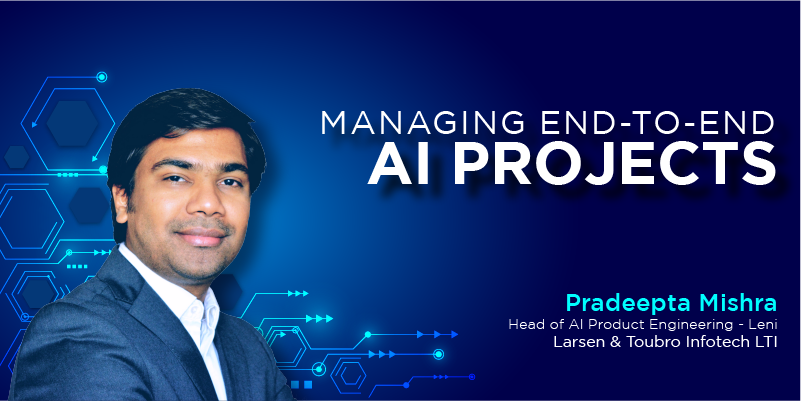Managing End-to-End AI Projects

AI projects need a different approach as it is different from conventional software development projects. The traditional software projects are solution specified and follow a top-down approach. When there is no specified solution, the outcome for software projects is unpredictable and risky. However, AI projects follow a bottom-up approach and draw conclusions by working with a huge amount of data sets. The major difference of an AI project from a traditional IT project is that AI/ML intervention is required at least in one stage of the artificial intelligence project lifecycle.
What is an AI Project?
Most of the problem solutions that we confront today have more than one layer of intelligence is enabled. For example, the automatic suggestions appear while typing a WhatsApp message, which is nothing but the intervention of bi-directional LSTM model. It creates a dictionary of vocabulary based on the typing history that enables it to suggest relevant words.
Similarly, you can see advertisements on websites/blogs that are relevant to the content. Such advertisements are known as contextual advertisements. Another example is reinforcement learning on your mobile gaming applications. Whenever you cross a certain level of the game in a gaming application, it automatically takes you to the next difficulty level. This kind of learning is known as reinforcement learning
Hence, any project that needs any kind of machine learning/deep learning models or any other kind of learning models can be called as an AI project.
Another definition for an AI project is that any project that requires the integration of a decision-support engine. While you’re applying for a home loan, the calculator integrated with the system will predict whether you’re eligible or not eligible to get a loan, which acts as a decision-support engine.
When a project requires prediction, algorithmic intervention, or rule-driven system, such a project is also considered as an AI project.
AI Project Lifecycle
An AI project lifecycle is defined as the steps taken by the organization to run the project smoothly. To deploy a successful artificial intelligence project, organizations should adopt an all-inclusive approach that covers project scope to fully developed AI project.
- Project Scoping
Every AI project will start with a challenge or problem, which can be a generic or specific problem statement. How do we recognize a problem statement? For example, how do we identify the difference between a fake product review and a genuine product review? Can an AI/ML engine recognize the difference?
Challenge statement is a one-line statement that is at a higher level, but to break the problem statement and scope out is like a classification problem. Hence, you can train a classifier to find the solution for the problem statement.
It is a naïve approach to jump into a conclusion that you will train a classifier to differentiate between two. To understand the scope of the project, there is a need to analyze the problem at different levels by selecting relevant use cases. Based on the use cases defined, an AI model has to be built to find the solution. Prioritizing the problem statement based on the complexity and sequential order of the complexities to define the possible outcome.
- Designing a Model
Next phase is the design phase which is a time-consuming stage and requires a development strategy. In the design phase, one has to establish communication links between the problem and the software components. Usually, the communication happens using right APIs. But what kind of APIs is also important or whether the project involves machine learning/deep learning models.
During the design phase, the design architects have to analyze various information to decide which kind of information is suitable for designing the models. At least 90% of the entire designing procedure have to be completed in the design phase itself and rest 10% may tend to change if a better approach has been identified. Completion of 90% of the design enables you to proceed to the development phase of the model.
The development leads and design architects have to work together on different aspects such as information source, target actions, process stages, dynamic behaviors, etc.
- Developing a Model
Once the problem statement has been outlined and design requirements are identified, the development phase of the AI project begins. Based on the difficulty level of the project, this phase may take up a few days to several months. The development phase includes basic data analysis, determining the case scenarios, data preparation, scripting for the model, training of the model, evaluating the model, and publishing of the model.
- Deployment of AI/ML Model
In the deployment stage of AI lifecycle, you should integrate the ML/DL models into various applications and processes that help to make the right business decisions. The model has to be deployed effectively to gain value out of it. Hence, you have to perform the code review, unit testing, analyze the real-time data, scalability, and trigger the set up for the deployment of the model.
The trained model undergoes scrutiny though a GIT repository, which includes the CI/CD (continuous integration/continuous delivery) pipeline. Apart from this, any details relevant to the project such as data, flows, scripts, etc., are used to build the model.
The CI/CD approval process begins with a series of actions that use scripts for data validation, which will be pushed into the binary repository of the enterprise. This triggers other CI/CD processes for unit testing that validates the quality and performance of the model. Once the quality and performance testing have been completed, the deployment will be initiated through the CI/CD process.
- Testing/QA
Testing or quality analysis will be performed after the deployment of the model. It involves thorough evaluation and testing of model behaviors after deployment, which evaluates whether the model is meeting the expectations. Once the testing is completed, the model can go live.
- Monitoring
Monitoring of an AI/ML model will be performed once it goes live in order to analyze whether it is working perfectly or not. Monitoring helps to understand whether there is a requirement of fine-tuning for the model.
- Improvement
The final stage of an AI project is to determine whether there is any scope of improvement to solve the problem or in the delivery of the project. If there is a room for improvement, then you have to identify the different areas of improvement.
Dos and Don’ts of an AI Project
- Do not start off with tools first
Rather than thinking about tools and programs, one must consider the quality of the data available. Any AI solutions are data-driven and AI project lifecycle depends on the right data. Data labeling is also important because data is distributed across various applications and formats in organizations. The success of an AI project depends on the quality of data that is used to build models for producing accurate solutions and outcome.
- Do ensure to get the right data
The data scientists must understand the data and context clearly. A complete understanding of the impact of the data and new features in overall accuracy and computations is required. It is not possible to include any kind of data in the algorithm and expect a great result. Hence, it is necessary to put the right kind of numeric data in the algorithm to expect the right kind of output.
- Do not use of jazzy tools and techniques
Use simpler algorithms rather than jazzy ones or tools that are scalable and explainable. In majority of the projects, the various algorithms used today are linear regression, logistic regression, time-series forecasting and clustering. Simpler algorithms always help you to explain the behavior of the model.
- Do not use numerous competing tools that offer similar results
Benchmarking of tools and frameworks is very much important in an AI project to get the right output. The best way to decide the right tool is to experiment with various tools and benchmark the tool to be used in your project.
- Do build the team with AI experience
The shortage of experienced AI experts is another major challenge. AI and machine learning are relatively new technologies in the industry. Hence, the industry is experiencing a talent shortage as there is a dire need of people who understand the AI lifecycle and implement the complex algorithms of machine learning. Because of the lack of right talent, the full potential of ML applications is not used.
- Do follow Ethics and avoid Bias
Today, organizations are leveraging AI and data to develop scalable solutions, they have also have to confront with regulatory compliances and legal risks. Ethical issues and bias can affect the data selection process and development of the prediction model. Hence, it is mandatory to reduce the degree of bias and ethical issues involved in building an accurate and valuable AI/ML business model.
Conclusion
Managing an end-to-end successful AI project could be challenging and needs constant monitoring and improvement. Successful implementation of the project is possible with the right mix of the team, tools, frameworks and data.



